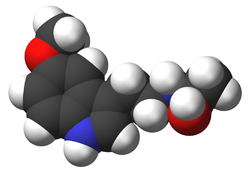Melatonin
Melatonin is a hormone found in animals, plants, and microbes.[1][2][3] In animals, levels of melatonin have a daily cycle. It drives the circadian rhythms of several biological functions.[4]
Melatonin is produced in the pineal gland which is outside of the blood–brain barrier. It acts as a hormone, and is released into the blood.[5]
Melatonin acts on melatonin receptors.[6] It also acts directly because it is a powerful antioxidant,[7] which protects DNA.[8]
Melatonin supplements for humans can be given. Melatonin is categorized by the US Food and Drug Administration (FDA) as a dietary supplement, not a drug.[9] A prescription-only, timed release melatonin product for people aged 55 and over was approved for use by the European Medicines Agency in 2007, despite having shown only small effects,[10] and in Australia in 2009.[11]
It is often given to young people with sleep problems.[12]
Melatonin Media
References
- ↑ "Melatonin". Sleepdex. Archived from the original on 2015-09-24. Retrieved 2011-08-17.
- ↑ Caniato R.; et al. (2003). "Melatonin in Plants". Developments in Tryptophan and Serotonin Metabolism. Advances in Experimental Medicine and Biology. Vol. 527. pp. 593–7. doi:10.1007/978-1-4615-0135-0_68. ISBN 978-0-306-47755-3. PMID 15206778.
- ↑ Paredes S.D.; et al. (2009). "Phytomelatonin: a review". J. Exp. Bot. 60 (1): 57–69. doi:10.1093/jxb/ern284. PMID 19033551.
- ↑ Altun A. & Ugur-Altun B. (2007). "Melatonin: therapeutic and clinical utilization". Int. J. Clin. Pract. 61 (5): 835–45. doi:10.1111/j.1742-1241.2006.01191.x. PMID 17298593. S2CID 18050554.
- ↑ Kaur C. & Ling E.A. (2008). "Antioxidants and neuroprotection in the adult and developing central nervous system". Curr. Med. Chem. 15 (29): 3068–80. doi:10.2174/092986708786848640. PMID 19075654.
- ↑ Boutin J.A.; et al. (2005). "Molecular tools to study melatonin pathways and actions". Trends Pharmacol. Sci. 26 (8): 412–9. doi:10.1016/j.tips.2005.06.006. PMID 15992934.
- ↑ Hardeland R (2005). "Antioxidative protection by melatonin: multiplicity of mechanisms from radical detoxification to radical avoidance". Endocrine. 27 (2): 119–30. doi:10.1385/ENDO:27:2:119. PMID 16217125. S2CID 46984486.
- ↑ Reiter R.J.; Acuña-Castroviejo; Tan; Burkhardt; et al. (2001). "Free radical-mediated molecular damage. Mechanisms for the protective actions of melatonin in the central nervous system". Ann. N.Y. Acad. Sci. 939 (1): 200–15. Bibcode:2001NYASA.939..200R. doi:10.1111/j.1749-6632.2001.tb03627.x. PMID 11462772. S2CID 20404509.
- ↑ Buscemi N.; et al. (2004). "Melatonin for treatment of sleep disorders" (PDF). Evidence Report/Technology Assessment #108. Agency for Healthcare Research and Quality (AHRQ), US Department of Health and Human Services (108): 1–7. doi:10.1037/e439412005-001. PMC 4781368. PMID 15635761. Archived from the original (PDF) on 3 May 2013. Retrieved 5 June 2013.
- ↑ European Medicines Agency. "Circadin, melatonin". European Public Assessment Report (EPAR). European Medicines Agency. Archived from the original on 21 February 2018. Retrieved 5 June 2013.
- ↑ Therapeutic Goods Administration (TGA). "Australian Public Assessment Report for Melatonin" (PDF). Department of Health and Ageing, Australian Government. Archived from the original (PDF) on 3 September 2013. Retrieved 5 June 2013.
- ↑ Robinson, Julia. "Number of children prescribed melatonin up 170% in seven years". The Pharmaceutical Journal. Retrieved 2023-02-10.



